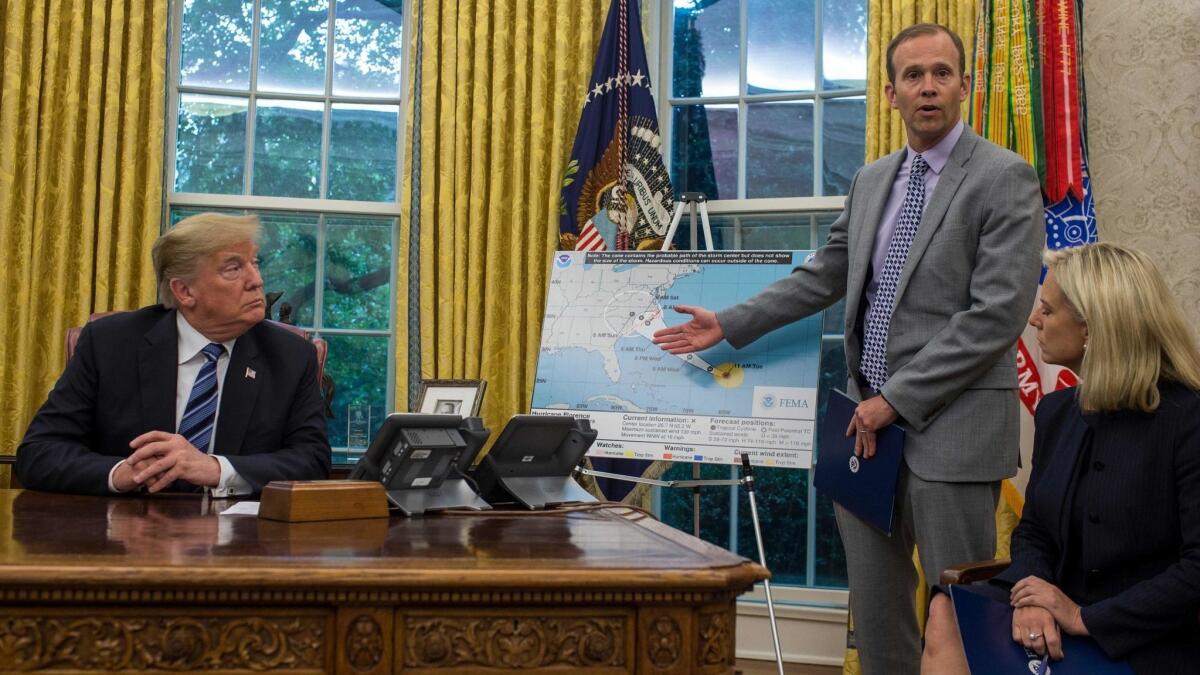For President Trump, a strong response to Hurricane Florence may be key to political future

- Share via
Reporting from Kinston, N.C. — Even before Hurricane Florence made landfall in North Carolina, President Trump was kicking up a storm of controversy.
Outraged over criticism of his handling of Hurricane Maria last year in Puerto Rico, he falsely blamed Democrats for inflating the death toll to 3,000. Discounting an academic study produced by George Washington University and accepted by the island territory’s local government, Trump tweeted that the number had arisen “like magic.”
The barrage of angry tweets guarantees that his handling of the current storm, which is still battering North and South Carolina, will be under the microscope. Eleven people had been reported dead by Saturday evening, and hundreds needed to be rescued from flooded homes.
Hurricanes have been political minefields for presidents in the past, most notably President George W. Bush. He was excoriated over his administration’s poor handling of Hurricane Katrina, which killed between 1,000 and 1,800 people in 2005.
Bush’s delay in visiting New Orleans was fiercely criticized — he was infamously photographed looking down on the city from a window on Air Force One.
The controversy over Katrina contributed to Bush’s political problems, which included a war in Iraq that was longer and bloodier than his administration had promised, and Democrats won back control of Congress the following year.
This year, Democrats are angling to pry the U.S. House of Representatives away from Republicans.
Trump’s job performance is already a key issue in the midterm election in November. Despite strong economic numbers, he remains deeply unpopular. The Real Clear Politics average of polls places his disapproval rating at 53.4% and his approval rating at 40.9%.
It’s unclear, however, how much Hurricane Florence might affect voters’ decisions.
Opinions about Trump have largely hardened, with Republicans making excuses for his missteps and Democrats adding to their list of outrages.
The White House has taken pains to show the president is on top of the situation. Days before the storm made landfall, reporters were ushered into the Oval Office for a briefing with Trump, Federal Emergency Management Agency Administrator Brock Long and Homeland Security Secretary Kirstjen Nielsen.
On Saturday evening, the White House released a photo of Trump on the phone with emergency officials as Vice President Mike Pence stands to his right with arms crossed.
The president is also planning to visit the region next week “once it is determined his travel will not disrupt any rescue or recovery efforts,” White House Press Secretary Sarah Huckabee Sanders said in a statement.
Trump hasn’t stopped tweeting grievances about his political opponents, but he has mixed in positive messages about the response to the storm.
“Great job FEMA, First Responders and Law Enforcement — not easy, very dangerous, tremendous talent,” he tweeted on Friday. “America is proud of you. Keep it all going — finish strong!”
Trump expressed sadness and support for Florence’s victims on Saturday evening in another tweet — “Deepest sympathies and warmth go out to the families and friends of the victims. May God be with them!” — but he appeared to have outdated information, mentioning only five deaths. By the time he tweeted his message, the toll had risen to at least 11.
It’s too soon to fully assess the federal government’s performance in Hurricane Florence. The operation has been massive, including local first responders, out-of-state emergency crews and National Guard units.
But South Carolina Gov. Henry McMaster, a Republican and early Trump supporter, said he had spoken to Trump, who told him his state would get what it needed.
“He has said they would do whatever it takes to see that everything is available for South Carolina,” McMaster said.
Times staff writer Laura King contributed to this report from Washington.
Follow the latest news of the Trump administration on Essential Washington »
Twitter: @chrismegerian
More to Read
Get the L.A. Times Politics newsletter
Deeply reported insights into legislation, politics and policy from Sacramento, Washington and beyond. In your inbox three times per week.
You may occasionally receive promotional content from the Los Angeles Times.











